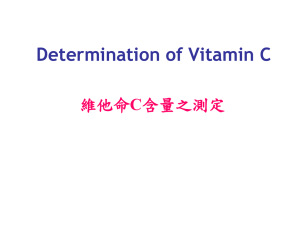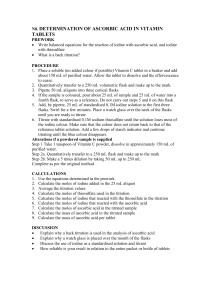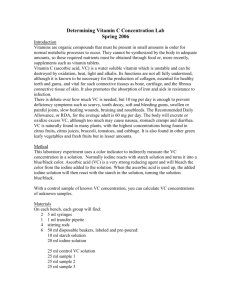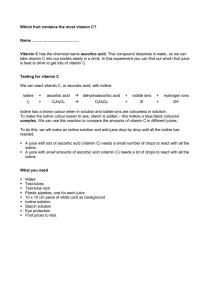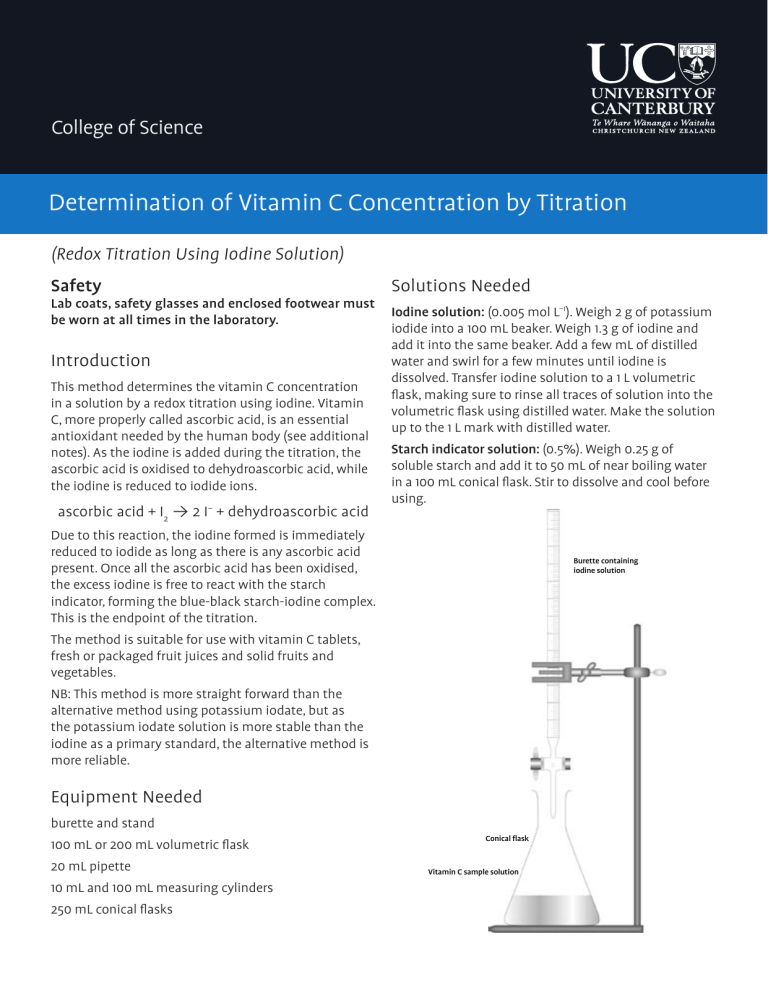
College of Science Determination of Vitamin C Concentration by Titration (Redox Titration Using Iodine Solution) Safety Lab coats, safety glasses and enclosed footwear must be worn at all times in the laboratory. Introduction Solutions Needed Iodine solution: (0.005 mol L−1). Weigh 2 g of potassium iodide into a 100 mL beaker. Weigh 1.3 g of iodine and add it into the same beaker. Add a few mL of distilled water and swirl for a few minutes until iodine is dissolved. Transfer iodine solution to a 1 L volumetric flask, making sure to rinse all traces of solution into the volumetric flask using distilled water. Make the solution up to the 1 L mark with distilled water. This method determines the vitamin C concentration in a solution by a redox titration using iodine. Vitamin C, more properly called ascorbic acid, is an essential antioxidant needed by the human body (see additional Starch indicator solution: (0.5%). Weigh 0.25 g of notes). As the iodine is added during the titration, the soluble starch and add it to 50 mL of near boiling water ascorbic acid is oxidised to dehydroascorbic acid, while (Redox Titration the iodine is reduced to iodide ions. Using Iodine Solution)in a 100 mL conical flask. Stir to dissolve and cool before using. − ascorbic acid + I2 → 2 I + dehydroascorbic acid Introduction Thisiodine method determines vitamin C concentration Due to this reaction, the formed istheimmediately in a solution by a redox titration using iodine. Vitamin reduced to iodide as long as there is any ascorbic acid C, more properly called ascorbic acid, is an essential Burette containing present. Once all the ascorbic has been oxidised, iodine solution antioxidantacid needed by the human body (see additional notes). As the iodine added during the titration, the the excess iodine is free to react with isthe starch acid is oxidised to dehydroascorbic acid, while indicator, forming theascorbic blue-black starch-iodine complex. the iodine is reduced to iodide ions. This is the endpoint of the titration. − Determination of Vitamin C Concentration by Titration ascorbic acid + I2 → 2 I + dehydroascorbic acid The method is suitableDue fortouse with vitamin tablets, this reaction, the iodineCformed is immediately fresh or packaged fruitreduced juicestoand fruits and iodidesolid as long as there is any ascorbic acid present. Once all the ascorbic acid has been oxidised, vegetables. the excess iodine is free to react with the starch indicator, forming the blue-black complex. NB: This method is more straight forward thanstarch-iodine the This is the endpoint of the titration. alternative method using potassium iodate, but as method is is suitable use with vitamin the potassium iodate The solution more for stable than theC tablets, fresh or packaged fruit juices and solid fruits and iodine as a primary standard, vegetables.the alternative method is more reliable. NB: This method is more straight forward than the alternative method using potassium iodate, but as the potassium iodate solution is more stable than the iodine as a primary standard, the alternative method is more reliable. Equipment Needed burette and stand Equipment 100 mL or 200 mL volumetric flaskNeeded 20 mL pipette burette and stand 100 mL or 200 mL volumetric flask 10 mL and 100 mL measuring cylinders 20 mL pipette 250 mL conical flasks 10 mL and 100 mL measuring cylinders 250 mL conical flasks Solutions Needed Iodine solution: (0.005 mol L−1). Weigh 2 g of potassium Conical flask Vitamin C sample solution Method 4. Calculate the concentration in mol L−1 of ascorbic acid in the solution obtained from fruit/vegetable/ Sample 3.juice.Using equation the titration (below) StarchPreparation indicator solution: (0.5%). Weigh 0.25 g of Also, the calculate the of concentration, in mg/100mL determine the number of moles of ascorbic soluble starch and add it to 50 mL of near boiling water or mg/100g of ascorbic acid, in the sampleacid of fruit/ For vitamin C tablets: Dissolve a single tablet in 200 mL reacting. in a 100 mL conical flask. Stir to dissolve and cool before vegetable/juice. of distilled water (in a volumetric flask if possible). using. ascorbic acid + I2 → 2 I− + dehydroascorbic acid For fresh fruit juice: Strain the juice through Notes cheesecloth to remove seeds and pulp which may block Additional 4. Calculate the concentration in mol L−1 of ascorbic Method pipettes. 1. acid Iodine stains both skin and clothing so proper care is in the solution obtained from fruit/vegetable/juice. advised. If staining does occur, alcohol may remove ForSample packaged fruit juice: This may also need to be Also, calculate the concentration, in mg/100mL or mg/ Preparation skin stains and cleaners are available for fabric stains. strained through cheesecloth if it contains a lot of pulp 100g of ascorbic acid in the sample of fruit/vegetable/ For vitamin C tablets: Dissolve a single tablet in 200 mL or seeds. 2. juice. Vitamin C, or ascorbic acid, is a water soluble of distilled water (in a volumetric flask if possible). antioxidant that plays a vital role in protecting the For fruits and vegetables: Cut a 100 g sample into small For fresh fruit in juice: Strainand the juice through body from infection pieces and grind a mortar pestle. Add 10cheese mL Additional Notesand disease. It is not synthesised cloth to remove seeds and pulp which may block by the human body and therefore must be portions of distilled water several times while grinding 1.acquired Iodine stains bothsources skin and– clothing proper from dietary primarilysofruits andcare thepipettes. sample, each time decanting off the liquid extract is advised. If staining does occur, alcohol may remove vegetables. The chemical structure and antioxidant intoFor a 100 mL volumetric flask. strain the packaged fruit juice: ThisFinally, may also need toground be skin stains and cleaners are available fabric stains. (reducing) action of ascorbic acid arefor illustrated in fruit/vegetable pulp through cheesecloth, rinsing the strained through cheese cloth if it contains a lot of pulp the redox halfC,equation below: 2. Vitamin or ascorbic acid, is a water soluble pulp a few 10 mL portions of water and collecting or with seeds. antioxidant that plays a vital role in protecting the body all filtrate and washings in the volumetric flask. Make For fruits and vegetables: Cut a 100 g sample into small 3. The concentration of the prepared iodine solution from infection and disease. It is not synthesised the extracted solution up to 100 mL with distilled water. can be more accurately determined by titrationby with pieces and grind in a mortar and pestle. Add 10 mL the human body and therefore must be acquired from a standard solution of ascorbic acid or a standard Alternatively the 100 g sample of fruit or vegetable portions of distilled water several times while grinding dietary sources – primarily fruits andusing vegetables. solution of potassium thiosulfate a starchThe may blendedeach in atime fooddecanting processoroff together withextract thebesample, the liquid chemical structure and antioxidant (reducing) action of about mL mL of distilled water. After blending, into50 a 100 volumetric flask. Finally, strainstrain the ground indicator. This should be done if possible as iodine ascorbic solutionsacid canare beillustrated unstable. in the redox half equation thefruit/vegetable pulp through cheesecloth, it with a fewthe pulp throughwashing cheese cloth, rinsing below: 10mL portions of distilled water, and makeand thecollecting extracted pulp with a few 10 mL portions of water HO HO solution up to 100washings mL in a volumetric flask. flask. Make all filtrate and in the volumetric oxidation O O O O HO + 2H+ + 2ethe extracted solution up to 100 mL with distilled water. HO Titration Alternatively the 100 g sample of fruit or vegetable may be blended a food processor togethersolution with about 1. Pipette a 20inmL aliquot of the sample into 50 mL of distilled water. After blending, strain the a 250 mL conical flask and add about 150 mL of pulp through cloth, washing it with asolution. few 10 distilled watercheese and 1 mL of starch indicator mL portions of distilled water, and make the extracted 2. Titrate the sample with 0.005 mol L−1 iodine solution. solution up to 100 mL in a volumetric flask. The endpoint of the titration is identified as the first permanent trace of a dark blue-black colour due to Titration the starch-iodine complex. HO OH ascorbic acid reduction O O dehydroascorbic acid 3. The concentration of the prepared iodine solution 4. can Thebe average titre volume should ideally be in the more accurately determined by titration with a range of 10 – 30 mL. If the titre required for a 20 mL standard solution of ascorbic acid or a standard solution aliquot of sample solution is well outside this range of potassium thiosulfate using a starch indicator. This then a larger or smaller aliquot volume should be should be done if possible as iodine solutions can be chosen. If the volume of the titre is too low, dilute unstable. the standard. If the titre volume is too high, dilute 3. Repeat the titration further aliquots sampleinto 4. 1. Pipette a 20 mLwith aliquot of the sampleofsolution The average titre volume should ideally be in the sample. solution youflask obtain results (titres a 250 mLuntil conical andconcordant add about 150 mL of distilled the range of 10 – 30 mL. If the titre required for a 20 5. mL Ascorbic is susceptible by this agreeing mL). indicator solution. water andwithin 1 mL of0.1starch aliquotacid of sample solutiontoisoxidation well outside atmospheric oxygen over time. For this reason, the range then a larger or smaller aliquot volume should 2. Titrate the sample with 0.005 mol L−1 iodine samples be prepared immediately before be chosen.should If the volume of the titre is too low, dilute Calculations solution. The endpoint of the titration is identified as the titrations. However, if the samples have to bethe the standard. If the titre volume is too high, dilute the first permanent trace of a dark blue-black colour due prepared several hours earlier, oxidation can be 1. Calculate the average volume of iodine solution used sample. to the starch-iodine complex. minimised by the addition of a small amount of from your concordant titres. 5. is susceptible oxidation by acid (egacid 1 g oxalic acid perto 100 mL of sample 3. Repeat titration with reacting. further aliquots of sample oxalicAscorbic 2. Calculate thethe moles of iodine atmospheric oxygen over time. For this reason, the solution). solution until you obtain concordant results (titres 3. Using thewithin equation of the titration (below) determine samples should be prepared immediately before the agreeing 0.1 mL). 6. Identification of the endpoint in this titration is the number of moles of ascorbic acid reacting. titrations. However, if the samples have to be prepared significantly affected by the colouration of the several hours earlier, oxidation can be minimised by the − sample solution used. If the solutions are colourless ascorbic acid + I2 → 2 I + dehydroascorbic acid Calculations addition of a small amount of oxalic acid (eg 1 g oxalic or are pale in colour, there is no problem identifying acid per 100 mL of sample solution). 1. Calculate the average volume of iodine solution used from your concordant titres. 6. Identification of the endpoint in this titration is significantly affected by the colouration of the sample 2. Calculate the moles of iodine reacting. solution used. If the solutions are colourless or are pale in colour, there is no problem identifying the endpoint. For strongly coloured juices there can be a problem with theendpoint endpoint. Foritstrongly juices there can the and is advisedcoloured to carry out a “rough” be a problem with the endpoint and it is advised titration in order to become familiar with any distinct in colour, there is nochange problem identifying the endpoint. to carry out awhich “rough” titration order to(itbecome colour occurs at theinendpoint may For stronglyjust coloured a problem with be a juices darkening ofbethe colour) This will also help by familiar withthere anycan distinct colour change which the endpoint and it is advised to carry out a “rough” establishing anendpoint, approximate volume solution 1 Vitamin C tablet. Left photo: before endpoint, added iodine reacts occurs at the (itdistinct may justofbeiodate a darkening FigureFigure 1 Vitamin C tablet. Left photo: before endpoint, added iodinetitration in order to become familiar with any with ascorbic acid leaving the solution colourless. Centre photo: At the required. of the colour) This will also help by establishing an reacts with ascorbic acid leaving the solution colourless. colour change which occurs at the endpoint (it may titration endpoint all the ascorbic acid has reacted and the excess iodine injust colour, is no problem identifying thealso endpoint. Centrereacts photo: Atthe thestarch titration endpoint the ascorbic acid hasphoto: darkening of the colour) This will help bysolution with indicator to givealla pale blue colour. Right If be athere approximate volume of iodine required. 7. The above method may bewith used to carry out a For strongly coloured juices there can be a problem addition of1iodine continued after the the endpoint, further establishing an approximate volume of iodate solution reacted andFigure the excess reacts with starch indicator to give VitaminisCiodine tablet. Left photo: before endpoint, added iodineiodine-starch reacts in colour, there is no problem identifying the endpoint. number of interesting investigations regarding the endpoint and itabove is advised to carry out a “rough” is formed. in each of these images a flask showing pale ascorbic acidNB: leaving theIf solution colourless. Centre photo: At the the 7. The method may be used to carry out the a required. a palecomplex bluewith colour. Right photo: addition of iodine is continued after For strongly coloured juices there can be a problem with titrationof endpoint all the ascorbic acid has and the excess iodine blue colour the endpoint is shown forreacted comparison. concentration of vitamin C in various foods and drinks: titration in order to become familiar with any distinct the endpoint, further iodine-starch complex is formed. NB: in each of reacts with the starch indicator to give a pale blue colour. Right photo: If number interesting investigations regarding the 7.the endpoint The above method may to carry out a and it isof advised to carry out “rough” change which occurs at be theused endpoint (it amay addition of iodine is continued theblue endpoint, further these images a flask showing theafter pale colour ofiodine-starch the endpointcolour isnumber • Vitamin C content of different types of fruits/ of interesting investigations regarding the titration in order to become familiar with any distinct concentration of vitamin C in various foods and complex is formed. NB: in each of these images a flask showing the pale just be a darkening of the colour) This will also help by shown for blue comparison. colour of the endpoint is shown for comparison. concentration of vitamin C in various foods and drinks: vegetables/juices. colour change which occurs at the endpoint (it may establishing an approximate volume of iodate solution Figure 1 Vitamin C tablet. Left photo: before endpoint, added iodine reacts drinks: with ascorbic acid leaving the solution colourless. Centre photo: At the just be aCdarkening colour) This will also help by required. • Vitamin content ofofdifferent typesof ofdifferent fruits/ • Vitamin Cthe content types/brands of vitamin titration endpoint all the ascorbic acid has reacted and the excess iodine • Vitamin C content of different types of fruits establishing an approximate volume of iodate solution Figure Vitamin C tablet. Left photo: endpoint, iodine Ifreacts vegetables/juices. reacts1with the starch indicator to givebefore a pale blue colour.added Right photo: 7. The above method may be used to carry out a tablets. with ascorbic acid leaving the solution Centreiodine-starch photo: At the addition of iodine is continued after thecolourless. endpoint, further required. vegetables/juices. number of interesting regarding of thevitamin • Vitamin C content ofinvestigations different types/brands titration theinascorbic acid has reacted and the excess iodine complexendpoint is formed.allNB: each of these images a flask showing the pale • Vitamin CC content of tablets or in the reacts with the starch indicator to give pale blue colour. Right photo: If blue colour of the endpoint is shown foracomparison. concentration of vitamin inmay various foods and drinks: tablets. 7. The above method be used to carry outfood/drink a types/brands • Vitamin C content of different of addition of iodine is continued after the endpoint, further iodine-starch presence and absence of added oxalic acid or metal ions interesting investigations regarding • Vitamin ofofdifferent types of fruits/ complex is formed. NB: in each of these images a flask showing the pale •number VitaminCof Ccontent content tablets or food/drink in the the vitamin tablets. blue colour of the endpoint is shown for comparison. over various periods ofacid time. concentration of vitamin C inoxalic various foods and drinks: vegetables/juices. presence and absence of added or metal ions • Vitamin C content of tablets food/drink in the over various periods of time. • Vitamin C content of different types of fruits/ • Vitamin C content of different types/brands of vitaminor • Vitamin C content of food/drink before and after Figure 2 Commercial fruit juice. Left flask: before the endpoint, the colour presence and absence of added oxalic acid or vegetables/juices. tablets. content of food/drink before and after to cooking conditions. of theFigure solution reflectsfruit thejuice. paleLeft yellow ofendpoint, the fruitthejuice. Centre• Vitamin flask: Csubjection 2 Commercial flask: colour before the colour Figure At theoftitration endpoint allpale theyellow ascorbic andflask: any excess subjection to cooking conditions. the solution reflects the colouracid of thehas fruitreacted juice. Centre metal various periods of time. C content of tablets orover food/drink in the • Vitamin content ofCions different types/brands of vitamin 2 Commercial fruitwith juice. Leftallflask: beforetothe endpoint, the colour• Vitamin of the titration endpoint the ascorbic acid has reacted andblue-black any excess complex. •CVitamin content of fruits/vegetables at different iodineAtreacts the starch indicator form a dark presence and absence of added oxalic acid or metal ions • Vitamin C content of fruits/vegetables at different tablets. the solution reflects the pale yellow colour of the fruit juice. iodine reacts with the starch indicator to form a dark blue-black complex. In this case the result is a darkening of the solution’s colour from yellow • Vitamin C content of food/drink before and after stages of ripeness. In this result is aendpoint of all the solution’s colour from yellow periods of time. stages Centretoflask: At case thethe titration thethe ascorbic hasjust aover brown-grey. Right flask:darkening This illustrates effect ofacid adding mL various or of ripeness. to brown-grey. Right flask: This illustrates the effect of adding just a mL or • Vitamin C content of tablets or food/drink in the subjection tobefore cooking conditions. two more ofexcess iodine afterthethe endpoint is reached, resulting the reacted and any iodine with theis reached, starch indicator two more of iodinesolution solutionreacts after endpoint resulting in theto • in Vitamin C content of food/drink after presence and absence of added oxalicand acid or metal ions Figure 2 of Commercial fruit juice. Left flask: before the endpoint, the colour further iodine-starch complex. formation of further iodine-starch complex. form aformation dark blue-black complex. In this case the result is a darkening subjection toContact cooking conditions. of the solution reflects the pale yellow colour of the fruit juice. Centre flask: Us Contact Us • Vitamin C content of fruits/vegetables at different over various periods of time. At the titration endpoint all the ascorbic has reacted and any excess of the solution’s colour from yellow toacid brown-grey. Right flask: C content of fruits/vegetables atrelating different iodine reacts with the starch indicator to form a dark blue-black complex. stages If• you have questions orripeness. comments to this IfCany you have any questions or relating to this Vitamin content of of food/drink before andcomments after This illustrates thetheeffect of adding just abefore mL the orcolour two more of iodine• Vitamin Figure Commercial juice. Leftof flask: endpoint, colour In this2case resultfruit is a darkening the solution’s from the yellow stages of ripeness. experiment, please contact us: subjection to cooking conditions. the solution reflects the pale yellow colour of the fruit juice. Centre flask: solutionofafter the endpoint is reached, resulting in the formation of to brown-grey. Right flask: This illustrates the effect of adding just a mL or experiment, please contact us: of iodine solution afterascorbic the endpoint is reached, the Attwo themore titration endpoint all the acid has reactedresulting and any in excess further iodine-starch complex. formation of further iodine-starch complex. Outreach • Vitamin C content ofUs fruits/vegetables at different Contact Outreach Contact Us College of stages ofScience ripeness. College of Science of Canterbury IfUniversity you haveIfany questions or comments relating to this you have any questions or comments relating to this University ofus:Canterbury Private Bag 4800 experiment, please contact experiment, please contact us. Please note that this Christchurch ContactPrivate Us Bag 4800 Outreach service is for senior school chemistry students in New Zealand Christchurch If youofhave any questions or comments relating to this Science Figure 3 Freshly squeezed orange juice. Left flask: before the endpoint, the College New Zealand only. We regret we are unable to respond Phone: +64 3 364 2178contact Zealand colour of the solution reflects the bright orange colour of fresh orange juice University experiment, please us: ofNew Canterbury is unaffected by addition of iodine. Centre Once all the the ascorbic to queries from overseas. Fax: +64 3 364 2490 Figureand 3 Freshly squeezed orange juice. Leftflask: flask: before endpoint, the Bag 4800 oxidised, a slight excess of added iodine complexes with the Private Outreach Phone: +64 3 364 2178 colouracid of has thebeen solution reflects the bright orange colour of fresh orange juiceoutreach@canterbury.ac.nz Email: starch indicator, giving the solution a green colour in this case. This is the Christchurch CollegeOutreach ofFax: Science and isendpoint unaffected addition iodine. Centre Once the ascorbic +64 3 364 2490 of the by titration. Rightof flask: If further iodineflask: solution were all to be New Zealand www.outreach.canterbury.ac.nz acid has been a slight of added iodine complexes with the added, the oxidised, solution’s green colourexcess would become darker as shown. College of Science University of Canterbury Email: outreach@canterbury.ac.nz Figure 3 Freshly squeezed orange juice. Left flask: before thein endpoint, the This is the indicator, giving the solution a green colour this case. Phone: +64 3 364 2178 Private Bag 4800 colour of the solution reflects the bright orange colour ofbefore fresh orange juice Figurestarch 3 Freshly squeezed orange juice. Left flask: the endpoint, University of Canterbury endpoint of the titration. Right flask: If further iodine solution were to be and unaffected by addition of iodine. Centre flask: Once allcolour the ascorbic +64 3 364 2490 www.outreach.canterbury.ac.nz Christchurch the colour ofishas the solution reflects thewould bright orange freshFax: added, solution’s darkerwith asof shown. Private Bag 4800 acid the been oxidised,green a slightcolour excess of added become iodine complexes the orange juice is unaffected by addition of iodine. Centre flask: Email: Newoutreach@canterbury.ac.nz Zealand starchand indicator, giving the solution a green colour in this case. This is the Christchurch endpoint of thesqueezed titration. Right flask: Ifoxidised, further iodine solution were to beofthe 3 Freshly orange juice. Left flask: theexcess endpoint, Once allFigure the ascorbic acid has been abefore slight added www.outreach.canterbury.ac.nz +64 3 364 2178 added,ofthe colour would orange becomecolour darker of as fresh shown. colour thesolution’s solution green reflects the bright orange juice Phone:New Zealand iodine complexes with the starch indicator, giving the solution a and is unaffected by addition of iodine. Centre flask: Once all the ascorbic Fax: +64Phone: 3 364 2490 +64 3 364 2178 green colour inbeen thisoxidised, case. This isexcess the endpoint of the titration. acid has a slight of added iodine complexes with the Email: outreach@canterbury.ac.nz starch thesolution solution a green this case.the This is the Right flask: If indicator, furthergiving iodine werecolour to beinadded, solution’s Fax: +64 3 364 2490 endpoint of the titration. Right flask: If further iodine solution were to be www.outreach.canterbury.ac.nz green colour become as shown. Email: outreach@canterbury.ac.nz added,would the solution’s greendarker colour would become darker as shown. www.outreach.canterbury.ac.nz Figure 4 Red capsicum. Left flask: Before the endpoint, the solution iodine reacts with the starch indicator to form a dark blue-black complex. In this case the result is a darkening of the solution’s colour from yellow to brown-grey. Right flask: This illustrates the effect of adding just a mL or two more of iodine solution after the endpoint is reached, resulting in the formation of further iodine-starch complex. retains its original colour. Centre flask: Once all the ascorbic acid has been oxidised, a slight excess of added iodine forms a dark complex with starch indicator giving a purple colour. This is the titration endpoint. Right flask: If a further mL or two of iodine were to be added after the endpoint, the solution would develop the dark purple colour shown here. Figure 4 Red capsicum. Left flask: Before the endpoint, the solution Red capsicum. Left Centre flask: Before theOnce endpoint, 3Figureits4original retains colour. flask: all the thesolution ascorbic acid has been retains its original colour. Centre flask: Once all the ascorbic acid has been oxidised, a slight excess of added iodine forms a dark complex with starch oxidised, a slight excess of added iodine forms a dark complex with starch indicator giving colour. the titration indicator givingaa purple purple colour. ThisThis is theistitration endpoint.endpoint. Right flask: Right flask: If a further mL iodine were be added the the endpoint, the If a further mLor or two two ofofiodine were to beto added after theafter endpoint, solution woulddevelop develop the dark purple colourcolour shown here. solution would the dark purple shown here. Figure 4 Red capsicum. Left flask: Before the endpoint, the solution Figure Red capsicum. LeftCentre flask:flask: Before endpoint, the 3 43retains its original colour. Oncethe all the ascorbic acid hassolution been oxidised, a slight excessCentre of addedflask: iodine forms darkthe complex with starch retains its original colour. Oncea all ascorbic acid has indicator giving a purple colour. This is the titration endpoint. Right flask: been oxidised, a mL slight excess ofwere added forms a dark complex If a further or two of iodine to beiodine added after the endpoint, the with starch indicator giving purple This here. is the titration solution would develop theadark purplecolour. colour shown endpoint. Right flask: If a further mL or two of iodine were to be 3 added after the endpoint, the solution would develop the dark purple colour shown here.
